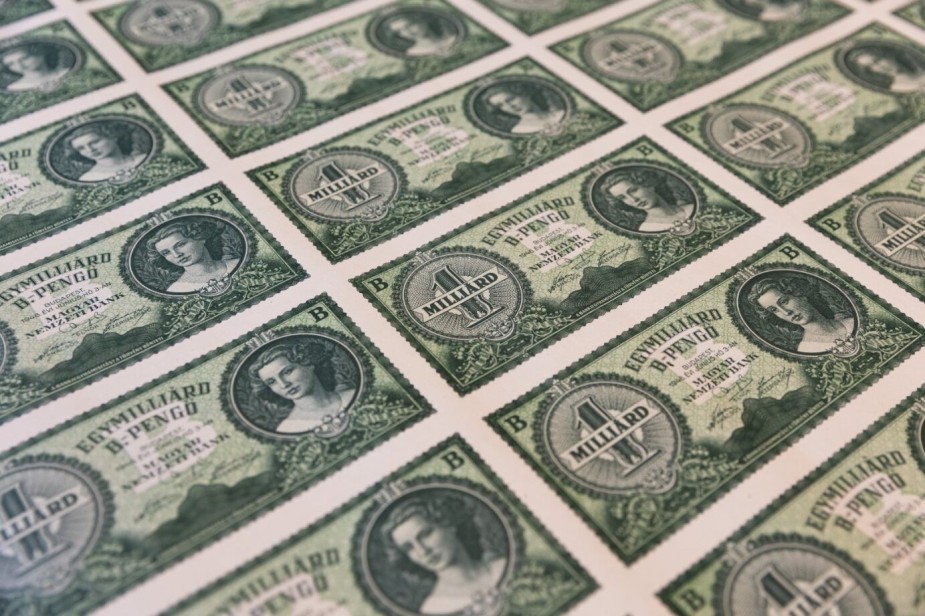
The one billion bilpengő, one of the iconic pieces of the pengő system, may not make us billionaires today, but the price of a single piece can even sell for half a million forints.
The pengő was introduced in Hungary on the 1st of January in 1927. Its purpose was to stabilise the economic crisis that had developed after the First World War, but it ended up suffering one of the worst hyperinflations in history. It was the country’s official currency until the 31st of July in 1946 and was replaced by the forint on the 1st of August.
Swept on the streets
At its inception, the largest denomination of the pengő was the 100 pengő bill, but in order to curb the hyperinflationary process, larger and larger denominations were issued. The sudden increase in denominations meant that the higher denominations had to be produced quickly, so the printing plates of the banknotes printed in 1926 were used again and again. In the end, the highest denominations were no longer numbered and were even printed offset.
Perhaps the best illustration of the incredible price increase is that the price of the weekly Ludas Matyi newspaper was 2 pengő in the May of 1945 when it was launched, then it rose to 2,000 pengő on the 1st of January in 1946, and then to 1,000 trillion pengő in July of the same year. Inflation peaked in July 1946, when the value of the pengő depreciated by 41,900 trillion in one month, which meant that prices doubled every 15 hours on average. The fall in the value of the pengő was so sudden that in the summer of 1946 banknotes were being swept on the streets, as captured by István Mizerák in his now iconic pictures of a street sweeper sweeping banknotes lying in the streets of the capital - these discarded, worthless banknotes were taken from the streets to the papermill of the Szolnok paper factory.
The introduction of the pengő was followed by the milpengő, then the one billion milpengő, but neither had the expected effect, and the bilpengő was finally introduced. The largest denomination was the one billion B. pengő, or trillion pengő, with Lúcia Lendvay of Székesfehérvár on the front and the value of the pengő on the reverse. It was the largest denomination ever issued in the world. The graphic design was created by Endre Horváth. However, this banknote never made it into circulation due to the introduction of the forint. When the new currency was introduced, 1 forint was worth 400 000 quadrillion (1029) pengő.
The dream of collectors
The banknote is in demand today, as it was not in circulation, few people ever received one and only a small number of copies were printed. It is interesting to note that the one billion bilpengő banknotes are known to have existed in 35 uncut sheets or fragments of sheets. It is rumoured that the sheets were taken home from the bank and then cut up inexpertly at home, which is why we can find inadequately sized originals folded in an arc.
In the numismatic world, the value of an artefact is estimated on the basis of several different criteria. These include its degree of rarity (how many copies were issued and how many have survived over time), its condition and its desirability in the collector's market. For this reason, there can be differing opinions about the value of a particular coin or banknote. It is not surprising, therefore, that when we talked to numismatists János Ádám, Csaba Endre and István Dombai, we also found diverging opinions on the value and frequency of the one billion bilpengő.
However, it can be said that the one billion bilpengő is an iconic piece of the pengő system, and collectors of that period regularly seek it out, with interest in it growing in recent years, not only in Hungary but also among foreign collectors. Naturally, this has also had an impact on selling prices. The increased demand inevitably leads to counterfeiters and dealers, which is why the novice collector should be careful and have the authenticity checked by an expert, because the phase prints that appear on the market are often fakes.
Based on the known facts, such items never find their way into the shops in the form of a piece that was found by the grateful posterity among the keepsakes of a grand or great-grandparent, but instead they come from collections or bequests. Interestingly, until 10 years ago, an uncut sheet could sometimes be found on the market. Nowadays, banknotes can be found on numismatic exchanges, and are offered for sale for around 300-500,000 forints, depending on their condition.
Written by: Lilla Bakonyi Photo by: András Horváth (Money Museum, Banknote and Medal Collection of the Central Bank of Hungary)
Further news
All newsThank you for your kind understanding!
The success of the HUNOR Program is now on display in the exhibition space
The Tarnay family brought silver bowls
Thank you for your kind understanding!
Thank you for your kind understanding!
The success of the HUNOR Program is now on display in the exhibition space
The Tarnay family brought silver bowls
Thank you for your kind understanding!



